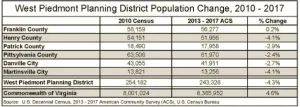Most of us are familiar with the Decennial Census – that full count of persons which takes place every ten years to determine how each state is represented via the U.S. House of Representatives, as well as to guide the disbursement of federal funding to localities, as noted on the Census Bureau’s website (https://www.census.gov/programs-surveys/decennial-census/2020-census/about.html).
In recent years, however, the U.S. Census Bureau has begun to conduct sample counts on an annual basis, which establishes intermittent population and housing counts in the years between the Decennial Census. This sample data, known as the American Community Survey (ACS), is conducted on the basis of one, three, and five year averages, depending on the size of the locality being analyzed, and the sample data is utilized to establish annual estimates.
RIDE Solutions staff analyzed population changes in the West Piedmont Planning District based on the recently-released five-year 2013 – 2017 ACS, which serves as an average over that five-year period. Staff compared this information with the 2010 Decennial Census to identify population trends occurring in the region. Data were compiled at the locality level, at the regional scale, and at the state level to highlight these trends. The table below summarizes these population counts and trends between the Decennial Census and the 2013 – 2017 ACS. The table shows that most localities, with the exception of Franklin County, experienced a population decline over the period analyzed, with the Commonwealth exhibiting modest growth of 4.6%.



